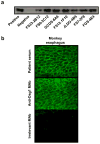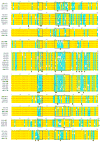Antigen selection of anti-DSG1 autoantibodies during and before the onset of endemic pemphigus foliaceus
- PMID: 19571823
- PMCID: PMC2847628
- DOI: 10.1038/jid.2009.184
Antigen selection of anti-DSG1 autoantibodies during and before the onset of endemic pemphigus foliaceus
Abstract
Fogo selvagem (FS), the endemic form of pemphigus foliaceus (PF), is characterized by pathogenic anti-desmoglein 1 (DSG1) autoantibodies. To study the etiology of FS, hybridomas that secrete either IgM or IgG (predominantly IgG1 subclass) autoantibodies were generated from the B cells of eight FS patients and one individual 4 years before FS onset, and the H and L chain V genes of anti-DSG1 autoantibodies were analyzed. Multiple lines of evidence suggest that these anti-DSG1 autoantibodies are antigen selected. First, clonally related sets of anti-DSG1 hybridomas characterize the response in individual FS patients. Second, H and L chain V gene use seems to be biased, particularly among IgG hybridomas, and third, most hybridomas are mutants and exhibit a bias in favor of CDR (complementary determining region) amino acid replacement (R) mutations. Strikingly, pre-FS hybridomas also exhibit evidence of antigen selection, including an overlap in V(H) gene use and shared multiple R mutations with anti-DSG1 FS hybridomas, suggesting selection by the same or a similar antigen. We conclude that the anti-DSG1 response in FS is antigen driven and that selection for mutant anti-DSG1 B cells begins well before the onset of disease.
Conflict of interest statement
The authors state no conflict financial interests.
Figures



References
-
- Anhalt GJ, Labib RS, Voorhees JJ, Beals TF, Diaz LA. Induction of pemphigus in neonatal mice by passive transfer of IgG from patients with the disease. N Engl J Med. 1982;306:1189–96. - PubMed
-
- Aoki V, Millikan RC, Rivitti EA, Hans-Filho G, Eaton DP, Warren SJ, et al. Environmental risk factors in endemic pemphigus foliaceus (fogo selvagem) J Investig Dermatol Symp Proc. 2004;9:34–40. - PubMed
-
- Beutner EH, Jordon RE. Demonstration of Skin Antibodies in Sera of Pemphigus Vulgaris Patients by Indirect Immunofluorescent Staining. Proc Soc Exp Biol Med. 1964;117:505–10. - PubMed
-
- Blier PR, Bothwell A. A limited number of B cell lineages generates the heterogeneity of a secondary immune response. J Immunol. 1987;139:3996–4006. - PubMed
Publication types
MeSH terms
Substances
Grants and funding
LinkOut - more resources
Full Text Sources
Medical

